Did you know? 80% of buyers look forward to online searches before buying anything.
With the significant growth in e-commerce and online research, it’s no surprise that most consumers now conduct their initial search before they buy anything.
In the USA alone, a consumer spends an average of 2 hours and 51 minutes a day online to find products and services.
Therefore, for those who have been in the industry, the rapid growth of e-commerce is an obvious fact. But for those brand new to it all, it may come as a surprise that e-commerce is a growing trend. Specifically, due to the COVID-19 crisis, e-commerce has gained ground in total retail.
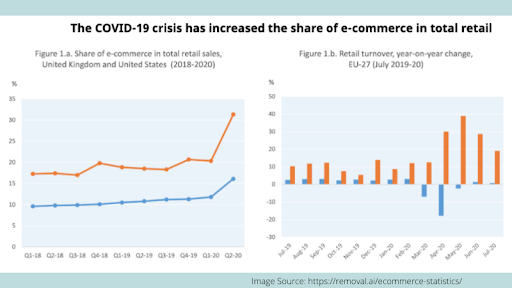
But one thing that everyone has to realize when designing an e-commerce website is that success doesn’t come without its costs. Creating one is no child’s play. It requires care and time in equal degrees to bring about an online store that is the perfect blend of aesthetics and functionality.
According to top eCommerce firms, the conversion rate for ecommerce websites is dreadful, with only 1.94 percent converting to purchase on average!
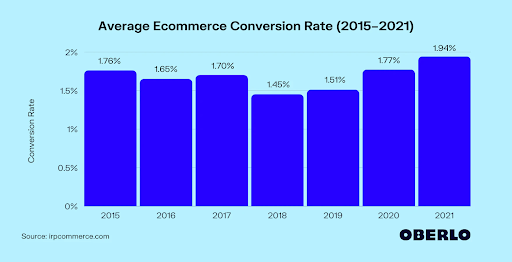
Plus, eCommerce websites are no longer just for large brands with big marketing budgets or small businesses with a specific market. In fact, you don’t even need to have your goods if you run an ecommerce site anymore–you can sell other people’s products as well!
In any case, running an online storefront comes with a range of costs, from the obvious to the obscure. Businesses should be aware of how much they’ll have to spend if they want an ecommerce website that’s efficient and effective.
So, let’s take a glimpse at the significant costs involved in building an ecommerce website. However, it is not going to be a never-ending list. Here, we’ve curated a list of some major costs that will govern the entire process.
Factors that Affect the Cost of Developing An Ecommerce Website
You might think it’s simple to create an ecommerce website, but what you may not realize is that many factors influence ecommerce website costs. If you aren’t paying close attention to each of these different cost factors, then your ecommerce website will end up costing far more than it should have.
This article explores some of the key factors that can affect the cost of developing an ecommerce website so that you can avoid budget overages.
1) Domain Name & Web Hosting
One of the most overlooked costs when starting an ecommerce business is domain name registration and web hosting. Domain names are essential because they’re what people will use to access your site; you can’t have a website without one. On the other hand, Web hosting refers to where your files live—the digital presence on which your business will stand.
Both domain names and web hosts are relatively inexpensive, but not having them can sink your ship before it ever leaves the harbor. They’re an absolute must-have, so do not try to skimp on this initial investment. Besides, get the best domain name for your company that you can afford, and purchase a web hosting plan that will grow your business into the future.
As of April 2021, the majority (52.3%) of global websites use only one top-level domain to access their pages; however, there are many different countries with unique cultures and languages represented on these sites! The .ru TLD was ranked second at 5.9%.
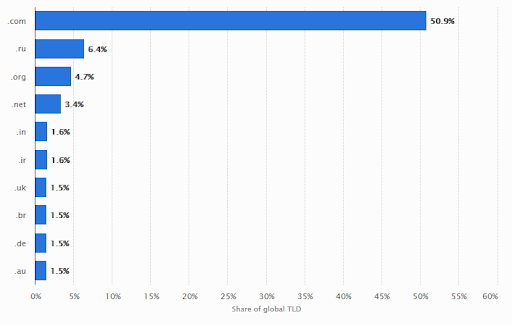
Image Source: Statista
Estimate Costing for Domain Names/Web Hosting:
Cost of registering a domain name – $10 to $20/year
Cost of web hosting for one year – $100 to $150/year
2) SSL Certificates
Your eCommerce website will need an SSL certificate. This is a form of encryption, which means all personal and payment information will be sent between you and your customers safely and securely.
It also provides trust and legitimacy to your site, which is essential for both customers and Google. More importantly, SSL certificates are not free. They usually cost $90 to $150 per year, so you’ll need to consider this when building out your ecommerce website budget.
SSL certificate authorities with more than 1% usage are shown in this diagram.

Image Source: w3techs
Estimated Costing for SSL certificate: $90 – $150/year
3) Development Time (UX, UI, Front-End, Back-End)
There are usually four components of an ecommerce website:
1. UX (User Experience)
2. User Interface (UI)
3. Front-end and Back-End.
Furthermore, each of these components is developed separately by different teams, which can also be developed at different times. For example, the UX team might work on the site wireframes first, then hand them off to the UI team to develop HTML/CSS.
This isn’t necessarily the order in that development needs to take place, but it does happen this way sometimes when you have multiple teams working together (which is almost always the case). Further, just keep in mind that each of these components can influence ecommerce website costs, so you need to consider them as they’re developed.
Now, let’s break down the various components of an ecommerce website and how much they cost to develop.
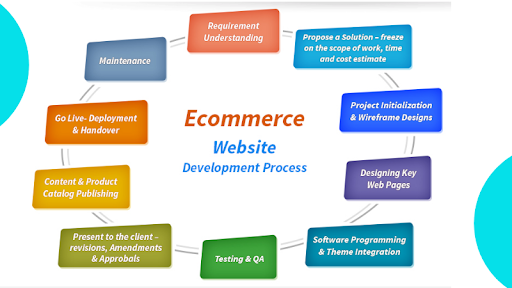
Requirement Understanding/Analysis
The very first step is to get a thorough understanding of the requirements provided by the client. This involves taking apart, piece by piece, all details regarding what’s needs to be done and developing an overall picture of the nature of work.
Wireframes and Prototypes
Once the client has approved, the next step is to develop wireframes and prototypes based on what was discussed during requirement understanding/analysis. These must be done in a way that gets approval from both business and technical team members.
Developing UX/UI Designs
The development of UX/UI designs involves the development of site architecture and page designs. It is usually done by UX/UI designers, although some developers also do it. At this stage, too, the business must get approval from both technical and non-technical team members before moving on.
Did you know? A good UX design can help in increasing a website’s conversion rate up to 200%.

Development of Front-End Development
After UI Design is approved, the front-end development process begins with developing HTML/CSS following the existing design. This is where the actual work on the front-end development begins.
Development of Backend Development
At this point, a database structure is devised to store the site’s content and images. The backend also services various other functionalities such as search, login, among others. It’s not uncommon for the client to set up a CMS (Content Management System) at this point, although it might be done separately.
Testing and Deployment
After the site’s development is complete, it goes through rigorous testing procedures to ensure everything works perfectly before deployment. The client must deploy their server at this stage. At last, we have a complete site as expected.
Maintaining and Updates
As with any other website, the site will need to be maintained and updated regularly. It can be done by either team members or clients who have been given access to the CMS. New pages and content can also be added periodically at this point. This is one of the most important parts since it helps to keep the site active on different social media platforms.
Ongoing Support Services
Once the site is live, it also requires ongoing support services to make sure everything works perfectly. If anything doesn’t, clients are given access through CMS to fix it themselves or get in touch with developer/design team members.
Usually, the time it takes to develop a website can vary from several days to several months. A complex ecommerce site might take about 3-6 months, while a simple one could be finished in less than a month. There is no set timeline that you can expect.
Besides, if you have a big project with a small team, the time it will take for you to complete the project will be a lot longer than if you have a huge team at your disposal. In short, if development time increases, the cost will increase as well.
Estimated Costing for Development:
UX Design: $5,000 – $10,000 (8 Weeks)
UI Design: $2,500 – $5 ,000 (6 Weeks)
Front-end Development: $7,500 – 10,000
Back-End Development: $3 ,500 – 7 ,500.
Project Total: Range from around $15,500 to $24,000
4) The Type of eCommerce Website You Want
All ecommerce websites are not created equal. Likewise, there are many different types of SMB businesses that need ecommerce options; there are also many ways to design an online storefront. Some of the most common options include:
Content management system (CMS)-driven template sites, like WordPress.
Custom HTML sites, which are developed using front-end development languages like HTML5 or CSS3.
A SaaS site that is developed on a software as a service (SaaS) platform.
Each of these options requires different levels of work and expertise, so that the prices will vary. You need to understand what it will take to develop the website you want and then factor those costs towards your budget.
Also, features you ask the app developers to include in your site can affect the final price. The more feature-rich the site you want, the higher the price is going to be. For instance, if you’re going to include a chat system, there will be an additional cost for that service. In short, the more features you ask for, the higher your costs are going to be.
Here are some standard features an eCommerce site has:
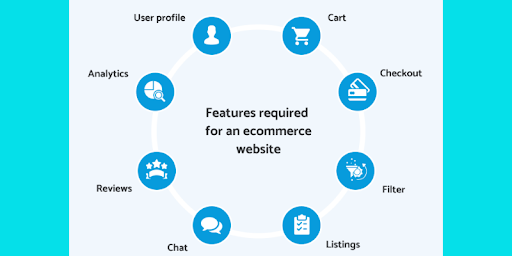
Estimated Costing for eCommerce Website:
1. CMS-driven template site – $5,000 – $10,000 (8 Weeks)
2. Custom HTML site – $10,000 – $20,000 (8 Weeks)
3. SaaS site – $15,000 – $30 ,000 (8-12 Weeks)
5) Add-on And Extension
There is no denying, add-ons and extensions are a great way to boost your eCommerce website’s functionality for a little extra cost. You can either purchase them from a third party or have an eCommerce development company create them from scratch. Extensions are commonly used to perform specific tasks, while add-ons improve existing features within a framework of core services.
Both can be added at any time, but you should make sure to consider the cost if they are needed upfront.
Estimated Costing for eCommerce Website Extensions and Add-ons:
Paid Add-Ons- Around $1,000
Paid Extensions- Around $5,000.
6) Outsource or in-house?
It’s important to remember that ecommerce site development costs can differ based on your company’s structure. Outsourcing may not make sense if you’re building an online store with its own IT staff for a larger business.
On the other hand, if you’re a small business without anyone on your team to take the lead on the technical aspects of your site, outsourcing can be a great solution. The choice comes down to what you have in place and your current level of expertise.
Suppose you are thinking of hiring Shopify Web Design & Development Company in India, then it might cost less to outsource your eCommerce site’s development.
The average hourly rates for software engineers are as follows:

1. Estimated Costing for Outsourcing: From $25/hr to $150/hr
2. Estimated Costing for In-House eCommerce Team: From $50/hr to $150/hr
7) eCommerce Website Maintenance Costs
eCommerce websites need constant upkeep and maintenance to remain successful. You’ll need to consider the cost of hosting your site, along with security updates. In addition, any add-ons or extensions you have will also need to be kept up to date.
Estimated Costing for eCommerce Maintenance Costs:- $100 – $200/month ($1,200 – $2,400 per year)
8) Payment Gateway
You probably already know that if you want to be successful online these days, you need an ecommerce website. But the problem is not every online business will succeed, especially with all of the new options available today. You can either sell products or services, but you need to make sure your website has the capabilities to accept payments from customers.
Estimated Costing to Implement Payment Gateway: $1,000 – $2,500
9) Shopping Carts
Shopping carts are a necessary component of ecommerce websites. They allow customers to browse, view and purchase items from your site with ease. If you have a SaaS website, this will be included as part of the monthly fee.
However, if you’re building a custom or template-based website on a CMS platform, you’ll need to purchase a shopping cart. The cost varies based on the platform you choose, but the price will likely be somewhere between $150 and $500.
Estimated Costing for eCommerce Shopping Carts: $150 – $500
10 ) Social Media Integration
Social media is popular among just about every demographic, so it’s necessary to include it on your website. You can integrate social media in several ways. A few of the most common include:-
1. Sharing social media profiles and feeds on your website
2. Including social sharing buttons for user convenience
Each approach has its benefits, but it’s important to remember that adding social media integration is a great way to increase engagement and help you gain more traffic and influence over time.
Estimated Costing for eCommerce Social Media Integration: $100 – $300
So there you have it – that’s a basic run-down on the types of expenses to expect when building an ecommerce website. Of course, this doesn’t include everything, but these are some of the most common costs online store owners face. Besides, if you’re planning to build an ecommerce website in the future, be sure to calculate these costs into your budget. Moreover, here is the overall cost & development process of an eCommerce website.
Estimated Costing for Building an Ecommerce Shop: $5,000 – $40,000
Wrapping Up!
So that’s it! You have a list of elements that go into creating your eCommerce website, and you also have a rough idea & clear thoughts of what the costs will be to create this online business.
Please note: All the above costing is just a rough estimate based on today’s market rates. Your web developer or digital agency should be able to provide you with detailed pricing information based on your specific requirements. Plus, you should hire eCommerce developers who have the expertise in developing eCommerce websites. This will ensure that your initial investment is worthwhile, and you will be able to create a successful online business.
FAQs
Q1: What are the stages of developing an online store?
A1: Developing an online store is a process of steps, which can be divided into four main stages.
1) Research & Define Your Audience
2) Create & Design Your Site
3) Launch
4) Promote And Measure Results
Q2: What are the benefits you can acquire by building an online store?
A2: The benefits of building an online store are multiple, including:
– Your business has an ecommerce solution.
– You have a 24/7 sales channel that can grow with your company.
– You can bring on more customers and increase sales with the internet.
– You increase revenue by providing new products and services online.
Q3: What are the features of a good ecommerce site?
A3: A good ecommerce website will have these features including:
– Ability to sell products and services from a central location.
– A clean & easy control panel for your website’s management.
– Extensive inventory features that can be expanded upon as needed.
– Advanced shipping and payment options tailored toward the buyer.
Q4: What are some tips on how to choose an ecommerce platform?
A4: Some tips on how to select an ecommerce platform include:
– Determine what type of technology you will need.
– Research the different security elements provided with the option you choose.
– Decide if it is necessary to use a content management system (CMS).
– Themes & User Experience (UX)
– eCommerce Platform Security
– Multiple Payment Gateways Support
Q5: Where Should I Build My Online Store?
A5: The best place to build your online store is to reach a reputed eCommerce development company or hire a dedicated eCommerce developer. They have the knowledge and experience to get your online store up and running in a short time. Some of them who are on the list of top eCommerce development companies are
1. PixelCrayons
2. ValueCoders
3. WebDesk Solution
4. MOBIKASA
5. Upside



